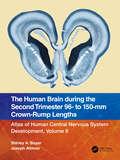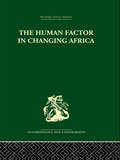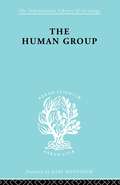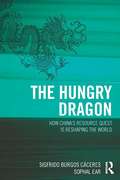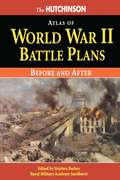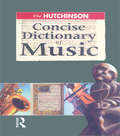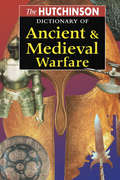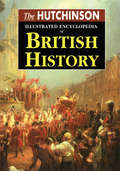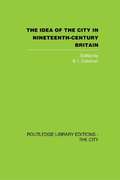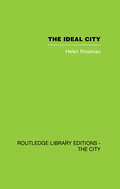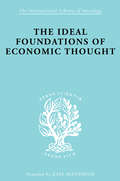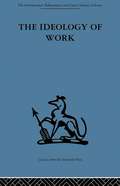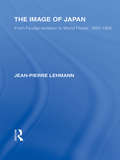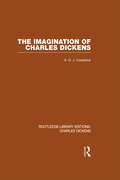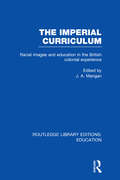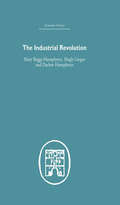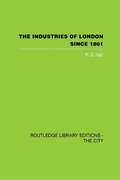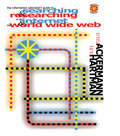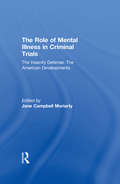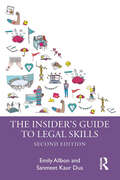- Table View
- List View
The Human Brain during the Second Trimester 160– to 170–mm Crown-Rump Lengths: Atlas of Human Central Nervous System Development, Volume 9
by Shirley A. Bayer Joseph AltmanThis ninth of 15 short atlases reimagines the classic 5-volume Atlas of Human Central Nervous System Development. This volume presents serial sections from specimens between 160 mm and 170 mm with detailed annotations. An introduction summarizes human CNS developmental highlights around 5 months of gestation. The Glossary (available separately) gives definitions for all the terms used in this voume and all the others in the Atlas. Features • Classic anatomical atlas • Detailed labeling of structures in the developing brain offers updated terminology and the identification of unique developmental features, such as germinal matrices of specific neuronal populations and migratory streams of young neurons • Appeals to neuroanatomists, developmental biologists, and clinical practitioners • A valuable reference work on brain development that will be relevant for decades
The Human Brain during the Second Trimester 190– to 210–mm Crown-Rump Lengths: Atlas of Human Central Nervous System Development, Volume 10
by Shirley A. Bayer Joseph AltmanThis tenth of 15 short atlases reimagines the classic 5-volume Atlas of Human Central Nervous System Development. This volume presents serial sections from specimens between 190 mm and 210 mm with detailed annotations. An introduction summarizes human CNS developmental highlights around 5 months of gestation. The Glossary (available separately) gives definitions for all the terms used in this volume and all the others in the Atlas. Features • Classic anatomical atlas • Detailed labeling of structures in the developing brain offers updated terminology and the identification of unique developmental features, such as germinal matrices of specific neuronal populations and migratory streams of young neurons • Appeals to neuroanatomists, developmental biologists, and clinical practitioners • A valuable reference work on brain development that will be relevant for decades
The Human Brain during the Second Trimester 96– to 150–mm Crown-Rump Lengths: Atlas of Human Central Nervous System Development, Volume 8
by Shirley A. Bayer Joseph AltmanThis eighth of 15 short atlases reimagines the classic 5-volume Atlas of Human Central Nervous System Development. This volume presents serial sections from specimens between 96 mm and 150 mm with detailed annotations. An introduction summarizes human CNS developmental highlights between 3.5 and 4.5 months of gestation. The accompanying Glossary (available free online) gives definitions for all the labels used in this volume and all the others in the Atlas. Key Features • Classic anatomical atlas • Detailed labeling of structures in the developing brain offers updated terminology and the identification of unique developmental features such as germinal matrices of specific neuronal populations and migratory streams of young neurons • Appeals to neuroanatomists, developmental biologists, and clinical practitioners • A valuable reference work on brain development that will be relevant for decades
The Human Brain during the Third Trimester 225– to 235–mm Crown-Rump Lengths: Atlas of Central Nervous System Development, Volume 11
by Shirley A. Bayer Joseph AltmanThis eleventh of 15 short atlases reimagines the classic 5-volume Atlas of Human Central Nervous System Development. This volume presents serial sections from specimens between 225 mm and 235 mm with detailed annotations. An introduction summarizes human CNS developmental highlights around 6.5 months of gestation. The Glossary (available separately) gives definitions for all the terms used in this volume and all the others in the Atlas. Key Features • Classic anatomical atlases • Detailed labeling of structures in the developing brain offers updated terminology and the identification of unique developmental features, such as germinal matrices of specific neuronal populations and migratory streams of young neurons • Appeals to neuroanatomists, developmental biologists, and clinical practitioners • A valuable reference work on brain development that will be relevant for decades
The Human Brain during the Third Trimester 260– to 270–mm Crown-Rump Lengths: Atlas of Central Nervous System Development, Volume 12
by Shirley A. Bayer Joseph AltmanThis twelfth of 15 short atlases reimagines the classic 5-volume Atlas of Human Central Nervous System Development. This volume presents serial sections from specimens between 260 mm and 270 mm with detailed annotations. An introduction summarizes human CNS developmental highlights around 6.5 months of gestation. The Glossary (available separately) gives definitions for all the terms used in this volume and all the others in the Atlas. Key Features • Classic anatomical atlases • Detailed labeling of structures in the developing brain offers updated terminology and the identification of unique developmental features, such as germinal matrices of specific neuronal populations and migratory streams of young neurons • Appeals to neuroanatomists, developmental biologists, and clinical practitioners • A valuable reference work on brain development that will be relevant for decades
The Human Brain during the Third Trimester 310– to 350–mm Crown-Rump Lengths: Atlas of Central Nervous System Development, Volume 13
by Shirley A. Bayer Joseph AltmanThis thirteenth of 15 short atlases reimagines the classic 5 volume Atlas of Human Central Nervous System Development. This volume presents serial sections from specimens between 310 mm and 350 mm with detailed annotations. An introduction summarizes human CNS developmental highlights around 9 months of gestation. The Glossary (available separately) gives definitions for all the terms used in this volume and all the others in the Atlas. Key Features • Classic anatomical atlases • Detailed labeling of structures in the developing brain offers updated terminology and the identification of unique developmental features, such as germinal matrices of specific neuronal populations and migratory streams of young neurons • Appeals to neuroanatomists, developmental biologists, and clinical practitioners • A valuable reference work on brain development that will be relevant for decades
The Human Factor in Changing Africa
by Melville J. HerskovitsFocussing on the problems of change and resistance to change that mark the African sub-continent, this book examines Africa's place in the world from earliest times. It considers the nature of its peoples in their prehistoric development, the ways in which their cultures were oriented, and the ways in which these cultures guided their reactions to European ideas. It also assesses the human responses to industrial, technological and economic changes and the re-discovery by the Africans of African culture. Originally published in 1962.
The Human Group (International Library of Sociology)
by George C. HomansPublished in 1998, The Human Group is a valuable contribution to the field of Sociology and Social Policy.
The Hungry Dragon: How China's Quest for Resources is Reshaping the World
by Sophal Ear Sigfrido Burgos CáceresThis volume provides an up to date and accessible examination of China's global search for resources, focusing primarily on oil. This focus provides a powerful rationale to explain China's actions overseas, as it impacts on economic, energy and foreign policies. A strong feature of the book is a comprehensive examination of geopolitical issues. Three country case studies (Angola, Brazil and Cambodia) are complemented by two chapters on opportunities and risks to China, and an examination as to how strategies are developed into tangible actions. This book also examines a number of overlapping debates regarding the varieties of capitalisms (autocratic vs. democratic), the urgent need for rebalancing as the world undergoes global crises, and the issues surrounding natural resources in the context of governance, liberal-oriented notions and poverty traps. The book is aimed at general as well as specialized readers and examines the subject in relation to international affairs, especially how the geopolitics of scarcity is driving states to be tenser, more observant of each other, and more acute to foreign initiatives.
The Hutchinson Atlas of World War II Battle Plans: Before And After
by Stephen BadseyThis text contrasts 21 World War II battle plans with their actual outcome. Each in-depth battle essay is complemented by original maps, producing fresh insight into the technical aspects of warfare that drove the last worldwide conflict of the 20th century. An overall introduction gives a strategic overview of the whole of the war, and places the individual battles into context. The battles are presented in seven groups of three, and each group is introduced by a short essay on the common theme for the group.
The Hutchinson Concise Dictionary of Music (Helicon Arts And Music Ser.)
by Barrie JonesThe Hutchinson Concise Dictionary of Music, in 7,500 entries, retains the breadth of coverage, clarity, and accessibility of the highly acclaimed Hutchinson Encyclopedia of Music, from which it is derived. Tracing its lineage to the Everyman Dictionary of Music, now out of print, it boasts a distinguished heritage of the finest musical scholarship. This book provides comprehensive coverage of theoretical and technical music terminology, embracing the many genres and forms of classical music, clearly illustrated with examples. It also provides core information on composers and comprehensive lists of works from the earliest exponents of polyphony to present-day composers.
The Hutchinson Dictionary of Ancient and Medieval Warfare
by HutchinsonFirst Published in 1999. Routledge is an imprint of Taylor & Francis, an informa company.
The Hutchinson Illustrated Encyclopedia of British History
by Simon HallFirst Published in 1999. Routledge is an imprint of Taylor & Francis, an informa company.
The Idea of the City in Nineteenth-Century Britain
by B. I. ColemanIn nineteenth-century Britain, ahead of the rest of the world in economic development, many towns and cities grew to a size that only London had attained before. This volume focuses on the intellectual and controversial response of the period's leading men and women to the key issues of urbanization and its surrounding social problems. The extracts selected date from 1785 to 1909, and are drawn from the writings, reports and speeches of admirers of city life and its most passionate critics, optimists and alarmists, advocates of back-to-the-land panaceas, and reformers who aspired to control and reform cities. Contemporaries quoted include Dickens, Cobbett, Carlyle, Disraeli, Engels, Mrs Gaskell, Ruskin, Joseph Chamberlain, William Morris, Charles Booth, H.G. Wells and Seebohm Rowntree. In a valuable introduction the editor indicates the main preoccupations of the debate abotu the city, proposes a periodization for it, adn shows its connections with other controversies and issues, as Victorian Britain found itself entering an 'age of great cities'. This book was first published in 1973.
The Ideal City: Its Architectural Evolution in Europe
by Helen RosenauThe concept of the 'ideal city' is, perhaps, more important today - when planners and architects are so firmly confined by considerations of our immediate environment - than ever before. Yet it is a concept which has profoundly influenced the western world throughout history, both as a regulative model and as an inspiration. Rosenau traces the progress of the concept from biblical sources through the hellenistic and Roman empires to the Renaissance and the later Age of Enlightenment, when the emphasis shifted from religious to social considerations. She goes on to discuss the resultant nineteenth-century ideal planning, when the idea of social betterment was approached with a specific and conscious effort. This book was first published in 1983.
The Ideal Foundations of Economic Thought (International Library of Sociology)
by Werner StarkPublished in 1998, The Ideal Foundations of Economic Thought is a valuable contribution to the field of Sociology & Social Policy.
The Ideology of Work (International Behavioural And Social Sciences Ser. #Vol. 71)
by P D AnthonyTavistock Press was established as a co-operative venture between the Tavistock Institute and Routledge & Kegan Paul (RKP) in the 1950s to produce a series of major contributions across the social sciences. This volume is part of a 2001 reissue of a selection of those important works which have since gone out of print, or are difficult to locate. Published by Routledge, 112 volumes in total are being brought together under the name The International Behavioural and Social Sciences Library: Classics from the Tavistock Press. Reproduced here in facsimile, this volume was originally published in 1972 and is available individually. The collection is also available in a number of themed mini-sets of between 5 and 13 volumes, or as a complete collection.
The Image of Japan: From Feudal Isolation to World Power 1850-1905 (Routledge Library Editions: Japan)
by Jean-Pierre LehmannJapan's image has experienced numerous transmutations. The book covers the metamorphosis from Japan's image of a feudal, exotic and romantic land inhabited by Madam Butterflies, to its sudden emergence as a geopolitical power following its defeat of Russia in 1905. More was to come. In the 1930s and 40s the image of the kamikaze vividly illustrated the fanaticism and barbarity associated with Japan in World War II. With the 1964 Tokyo Olympics, Japan rejoined the international community as a friend and ally of the US. The next transmutation came in the 1980s when the Japanese economy appeared to be functioning on anabolic steroids and its continued ascent to take over the US was predicted. "Japanese management" became more than a science, almost a religion, among business schools and consultancies. Today there are two images: one is conveyed through manga, karaoke and the global fashion for sushi; the other is of an economically and demographically declining nation. Will this image correspond to Japan's swan song or are there more transmutations on the way? One constant in Japanese history and the image it has projected has been the country's constant ability to surprise.
The Imagination of Charles Dickens: Routledge Library Editions: Charles Dickens Volume 3 (Routledge Library Editions: Charles Dickens)
by A. O. CockshutThis book describes Charles Dickens as an ordinary man who by being perfectly tuned to the public taste developed into a master of his art. The clue to this paradox lies, in the author’s opinion, in Dickens’ obsession with such topics as money, crowds and prisons which touch the life of everyone. From the deep fears of his childhood they became the main food for his imagination. As his creative mind worried over them, so his art developed. This process provided the driving force behind his work, and is at the root of his greatness as an artist.
The Imperial Curriculum: Racial Images and Education in the British Colonial Experience (Routledge Library Editions: Education)
by J. A. ManganThis volume presents the first comparative analysis of racial attitudes in the formal schooling of both Britain and its former dominions and colonies. The various contributions examine the issue right across the British imperial experience – with case studies ranging from Canada, Ireland, East and South Africa, through the Indian subcontinent to Australia and New Zealand. Racial indoctrination is considered from the perspective of both colonizer and colonized. The central theme throughout is that a racial hierarchy was taught through both curriculum and text in schools throughout the former British Empire.
The Industrial Revolution
by Mary Beggs-HumphreysFirst Published in 2005. Routledge is an imprint of Taylor & Francis, an informa company.
The Industries of London Since 1861
by P.G. HallHall argues that 'London was the chief manufacturing centre of the country in 1861, and without doubt for centuries before that'. This book looks at industries in London over time from 1861. This book was first published in 1962.
The Information Specialist's Guide to Searching and Researching on the Internet and the World Wide Web
by Karen Hartman Ernest AckermannWritten by a professor of computer science and a reference librarian, this guide covers basic browser usage, e-mail, and discussion groups; discusses such Internet staples as FTP and Usenet newsgroups; presents and compares numerous search engines; and includes models for acquiring, evaluating, and citing resources within the context of a research project. The emphasis of the book is on learning how to create search strategies and search expressions, how to evaluate information critically, and how to cite resources. All of these skills are presented as within the context of step-by-step activities designed to teach basic Internet research skills to the beginner and to hone the skills of the seasoned practitioner.
The Insanity Defense: The Role of Mental Illness in Criminal Trials
by Jane Campbell MoriartyWhether the accused is competent to stand trial, whether the plaintiff is competent to accuse, or whether a witness is competent to testify has had a long legal history. Such questions draw legal reasoning into areas of ethical reflection and scientific debate deeply rooted in the moral history of the United States. Mental competence has come to play a central and controversial role in proving guilt, and in evaluating the severity of a crime and its corresponding punishment. This compendium brings together the major legal precedents and legal commentaries that have defined the role of mental illness in criminal trials throughout U.S. history. The reprint collection considers, among other issues, the evolution of the Supreme Court's position on the insanity defense and mental retardation, how these affect one's competency to stand trial or be executed, and how these affect culpability and punishment. Each volume begins with an introductory essay, and includes both cases and commentary. Scholars as well as students will find these volumes a useful research tool.
The Insider's Guide to Legal Skills
by Emily Allbon Sanmeet Kaur DuaConfused by cases? Stuck on statutes? Or just unsure where to start with writing, research or revision? The Insider’s Guide to Legal Skills will show you what you need to succeed, applying skills in their real-world context and helping you get to grips with legal method and thinking. Making use of problem-based learning and examples throughout, the fully updated second edition of this practical and accessible guide will provide you with a clear guide to skills within the law degree, including online learning. It will show you how to make the most of these skills in assessment and also help you to see their importance to a future legal career. Designed for students who want a clear overview of what a law degree is all about, the book has been built on the skills curriculum, and is a suitable text for Legal Skills, Methods and Reasoning courses as well as a general introduction to law, or pre-reading for those considering a law degree.


